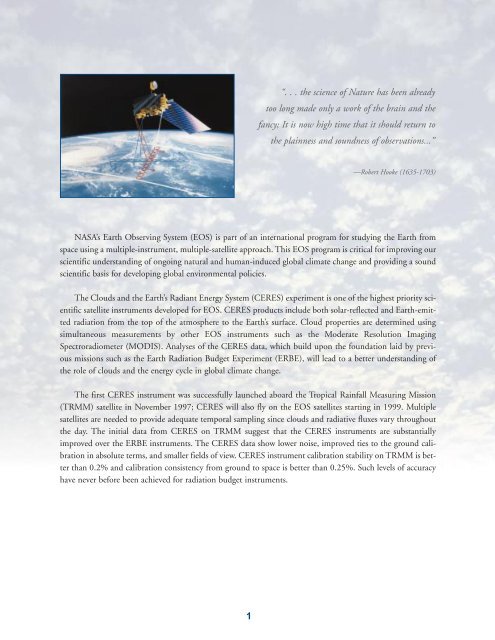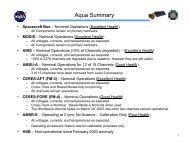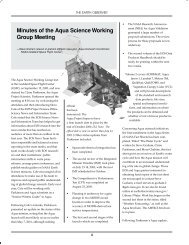CERES - Aqua - NASA
CERES - Aqua - NASA
CERES - Aqua - NASA
You also want an ePaper? Increase the reach of your titles
YUMPU automatically turns print PDFs into web optimized ePapers that Google loves.
“. . . the science of Nature has been alreadytoo long made only a work of the brain and thefancy; It is now high time that it should return tothe plainness and soundness of observations...”—Robert Hooke (1635-1703)<strong>NASA</strong>’s Earth Observing System (EOS) is part of an international program for studying the Earth fromspace using a multiple-instrument, multiple-satellite approach. This EOS program is critical for improving ourscientific understanding of ongoing natural and human-induced global climate change and providing a soundscientific basis for developing global environmental policies.The Clouds and the Earth’s Radiant Energy System (<strong>CERES</strong>) experiment is one of the highest priority scientificsatellite instruments developed for EOS. <strong>CERES</strong> products include both solar-reflected and Earth-emittedradiation from the top of the atmosphere to the Earth’s surface. Cloud properties are determined usingsimultaneous measurements by other EOS instruments such as the Moderate Resolution ImagingSpectroradiometer (MODIS). Analyses of the <strong>CERES</strong> data, which build upon the foundation laid by previousmissions such as the Earth Radiation Budget Experiment (ERBE), will lead to a better understanding ofthe role of clouds and the energy cycle in global climate change.The first <strong>CERES</strong> instrument was successfully launched aboard the Tropical Rainfall Measuring Mission(TRMM) satellite in November 1997; <strong>CERES</strong> will also fly on the EOS satellites starting in 1999. Multiplesatellites are needed to provide adequate temporal sampling since clouds and radiative fluxes vary throughoutthe day. The initial data from <strong>CERES</strong> on TRMM suggest that the <strong>CERES</strong> instruments are substantiallyimproved over the ERBE instruments. The <strong>CERES</strong> data show lower noise, improved ties to the ground calibrationin absolute terms, and smaller fields of view. <strong>CERES</strong> instrument calibration stability on TRMM is betterthan 0.2% and calibration consistency from ground to space is better than 0.25%. Such levels of accuracyhave never before been achieved for radiation budget instruments.1





